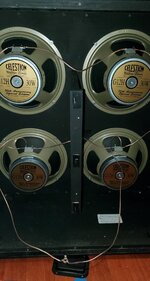Smash
Hack
I rewired my cab today with 12 awg. I didn't test how high I could go, but i got to 115 decibels and my power section wasn't over saturating me, and usually that is at around 110 that the power section gets involved, which is the only complaint i had about this amp at all. As far as if it sounds better or not, that would have to be if i left same exact eq, and that would be really hard to determine, but it is louder. I wired series-parrallel and checked for phase when all wired and with all 8 ohms came to about 7.3 ohms, so everything checked out well.
https://www.nytimes.com/wirecutter/reviews/the-best-speaker-cable/ used the wire out of this article, because it is a midgrade speaker wire.
After ordering the wire, I read that soldano used 12 gauge in his cabs, then I found out that bogner uses 10 gauge...That made me feel like a real loser for not using 6 gauge to beat them all.
https://www.nytimes.com/wirecutter/reviews/the-best-speaker-cable/ used the wire out of this article, because it is a midgrade speaker wire.
After ordering the wire, I read that soldano used 12 gauge in his cabs, then I found out that bogner uses 10 gauge...That made me feel like a real loser for not using 6 gauge to beat them all.
Attachments
Last edited:

